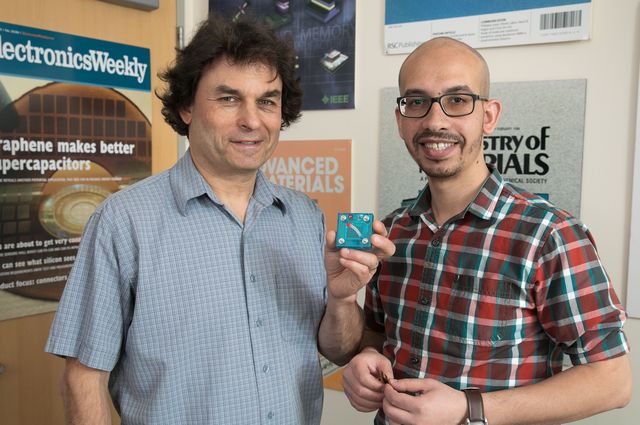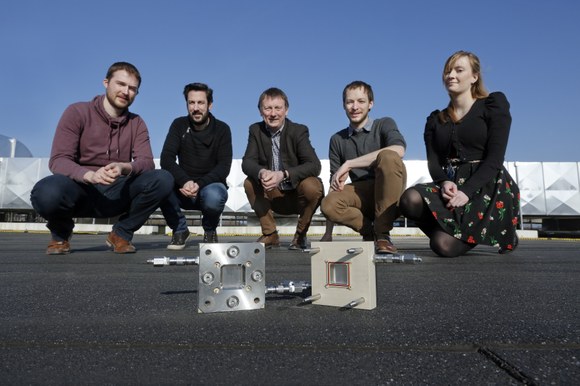Fahrt is German for drive, to clear things up immediately. Both Toyota and BMW are experimenting with the cruder form of the word, though, to bring about greener, cleaner driving. Both have bio-energy plans that use animal and even human waste to generate methane – a greenhouse gas that when burnt, combats air pollution. Variations on the theme may someday power our aircraft. Harold Bate and a Little Prehistory This is not a new idea. Harold Bate, a Devonshire farmer, became a counter-culture hero in the 1970s by powering his Hillman Minx sedan with manure. Like all visionaries, Harold was a bit ahead of his time, but became well known and envied when the Arab oil embargo of that decade left motorists waiting in line for fuel and confronted with rationing for the first time since WWII. The charming film from the National Film Board of Canada highlights the simplicity of his homegrown approach and the depth of his understanding. …
Three-in-One Device Stores Energy, Makes Hydrogen
UCLA researchers Richard Kaner and Maher El-Kady, “Have designed a device that can use solar energy to inexpensively and efficiently create and store energy, which could be used to power electronic devices, and to create hydrogen fuel for eco-friendly cars.” Kaner and El-Kady have devised many low-budget approaches to capturing and exploiting energy, such as their method of “burning” supercapacitors on a personal computer DVD. Their newest accomplishment, according to Kaner, “Could dramatically lower the cost of hydrogen cars.” It would be useful in urban or rural areas, or even on remote battlefields, giving users the ability to make both electricity and fuel from the same device. In cities, it could store surplus energy from electrical grids, and in more remote locations, allow energy generation and fuel creation “off the grid.” The pair’s replica of the device looks like a designer electronic gizmo encased in a turquoise plastic case. It uses inexpensive, abundant elements like nickel, iron and cobalt to …
Roof Top Hydrogen-Generating Solar Cells for Vehicles
Students at the University of Leuven, the Netherlands, have won the first Energy Award, sponsored by Febeliec – the association of industrial energy consumers, a Belgian trade association. Their miniature solar panel produces hydrogen gas when exposed to sunlight, not unlike “artificial leaves” of other researchers. The bioscience engineers crafted a small square panel that can be mounted to rooftops, including those of cars, to convert water vapor in the air to H2 that could feed fuel cells in the building or vehicle. This could also reduce CO2 “on a large scale to convert it into useful substances,” according to the team of young scientists. Generating electricity and producing hydrogen at the same time is a neat trick, but the roughly foot-square generators could be combined with more conventional solar cells to provide both electricity for immediate use and H2 to be stored for use on demand. This coexistence concept would help overcome the relatively low output for the current …
Direct Conversion of Sunlight to Hydrogen – Cheaply
We’ve witnessed several attempts to produce an “artificial leaf,” a device emulating the photosynthesis of plants, but providing hydrogen and oxygen that could power fuel cells in electric vehicles instead of plant sugars to make trees and flowers grow. One of the biggest problems so far has been the rare and costly materials necessary to generate hydrogen. Ècole Polytechnique Fédéral de Lausanne (EPFL) scientists have come up with a low-cost alternative, using abundant materials called perovskites and budget electrodes to produce hydrogen from water with a 12.3 percent conversion efficiency – a record for fairly common materials. Perovskites are a calcium titanium oxide mineral that come in a variety of colors and can be bog-common or extremely rare, approaching rare earth mineral status. The CaTiO3 used by Michael Grätzel is of the common variety, but that doesn’t seem to detract from its performance as a hydrogen-production agent. That, and the inexpensive materials used in the device’s electrodes cause Jingshan Luo, a post-graduate …
Taking That Fork in the Solar Road
Kyoung-Shin Choi, a chemistry professor at the University of Wisconsin-Madison, and postdoctoral researcher Tae Woo Kim combined forces to come up with a two-pronged approach for producing stored energy from mere sunlight. Many researchers take the familiar path of using expensive materials to extract the greatest percentage of energy from solar cells, but others use low-cost, less efficient organic materials spread across a greater area to get the same results. Choi and Kim, though, decided that selecting two different low-cost materials could give greater results – something a more single-path approach would miss. As their U of W report states, “Generating electricity is not the only way to turn sunlight into energy we can use on demand. The sun can also drive reactions to create chemical fuels, such as hydrogen, that can in turn power cars, trucks and trains.” The expensive semiconductors and catalysts normally used to transform sunlight to fuels are “far too expensive” to make competitive sun fuel possible, …
Solar Cells and Artificial Photosynthesis Make Hydrogen Directly
Science 2.0.com reports on an exciting potential breakthrough in solar energy and its direct transformation into hydrogen fuel. Usually, solar cells generate current from photons, making electricity which can run things or be stored in batteries. This new and different approach, using an innovative and inexpensive solar cell and a metal oxide photo anode, can store nearly five percent of solar energy chemically as hydrogen. The metal oxide bismuth vanadate (BiVO4) photo anode includes a small dose of tungsten atoms, was then sprayed onto conducting glass and “coated with an inexpensive cobalt phosphate catalyst,” which helped speed up oxygen formation during water splitting. Science 2.0 reports Professor Dr. Roel van de Krol’s remarks. He’s head of the Helmholtz Zentrum Berlin Institute for Solar Fuels, and worked with researchers there and at Deflt University. “Basically, we combined the best of both worlds. We start with a chemically stable, low cost metal oxide, add a really good but sim ple silicon-based thin …
Salt Plus Titanium Dioxide Plus Light Equals Hydrogen
Microorganisms found in salt flats could offer a new path to green hydrogen fuel, according to researchers at the U.S. Department of Energy’s Argonne National Laboratory. Argonne researchers say that some desert salt flats shelter “a protein found in the membranes of ancient microorganisms,” and could hold promise for generating hydrogen fuel in an “environmentally friendly” way. Salts come in a variety of colors, and each edible variety can lend a unique taste to recipes, but the purple salt used in the Argonne experiments can help make hydrogen. Elena Rozhkova is a scientist at Argonne’s Center for Nanoscale Materials in the Nanoscience and Technology Division. She develops her own research programs and works with users in the Center for Nanoscale Materials (CNM), where her work, “Intensely overlaps different kinds of sciences: materials science, chemistry, physics and biological sciences.” Her research develops nanobio hybrid materials, combining “inorganic nanomaterial and a soft biological material and combin[ing] them in hybrid structures with advanced …
Fuel Cell Progress in Britain
The National Renewable Energy Laboratory in Golden, Colorado released a document last year on the viability of fuel cells for various applications, including transportation. The National Fuel Cell Electric Vehicle Learning Demonstration Final Report, “analyzed data from more than 500,000 individual vehicle trips covering 3.6 million miles traveled and more than 152,000 [kilograms] hydrogen produced or dispensed.” The agency tested 180 vehicles over a six-year period. With United States Department of Energy expectations that fuel cell powered vehicles could achieve: • 250-mile driving range • 2,000-hour fuel cell durability • $3/gallon gasoline equivalent (gge) hydrogen production cost (based on volume production) At least two fuel cell manufacturers report results exceeding these numbers, so the major impediment to wide-spread implementation of this clean technology seems to be lack of an effective distribution network. The NREL lists 54 existing H2 sites, with 15 projected for the near future, nowhere near the estimated 159,000 outlets (including convenience stores) that sell gasoline and other …
Is This the Plop, Plop Fizz, Fizz of Energy?
Back in the early reaches of television advertising, one jingle was credited with nearly doubling sales of Alka-Seltzer, a popular over-the-counter remedy for acid indigestion. “Plop, plop; fizz, fizz, oh what a relief it is,” became a defacto instruction on how to use the pill, implying two were needed. Alka-Seltzer’s users got the idea and sales went up appreciably, reinforced by new instructions on the packaging. The sparkly image of the “cure” brings to mind a current effort by State University of New York at Buffalo researchers to drop nano-sized particles of silicon in water, with resulting bubbles of hydrogen escaping in large enough quantities to power portable devices. They have, “Created spherical silicon particles about 10 nanometers in diameter. When combined with water, these particles reacted to form silicic acid (a nontoxic byproduct) and hydrogen – a potential source of energy for fuel cells,” according to a UB press release. Most promising, the reaction does not require light, heat …



